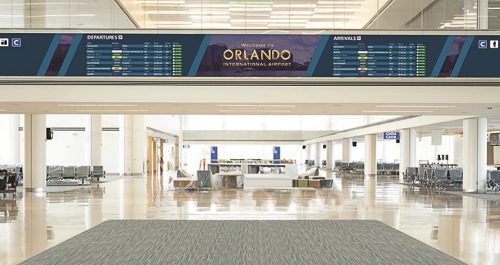From gate to curb and back again, guests traveling through the new $2.75 billion terminal at Orlando International Airport (MCO) will be fully immersed in The Orlando Experience® —complete with jaw-dropping multimedia displays, full-size palm trees and a baggage system with 100% tracking. (Yes, the airport is so serious about delivering The Orlando Experience®, it actually trademarked the phrase.)
From gate to curb and back again, guests traveling through the new $2.75 billion terminal at Orlando International Airport (MCO) will be fully immersed in The Orlando Experience® —complete with jaw-dropping multimedia displays, full-size palm trees and a baggage system with 100% tracking. (Yes, the airport is so serious about delivering The Orlando Experience®, it actually trademarked the phrase.)
 Scheduled to open this fall, the new 1.6 million-square-foot Terminal C is the jewel of MCO’s South Terminal Complex, which will connect to the airport’s new train station and will eventually include a Terminal D. Davin Ruohomaki, senior director of construction and engineering at the Greater Orlando Airport Authority (GOAA), notes that the $4.2 billion South Terminal Complex project is the largest in the airport’s history. Moreover, he says its innovative terminal and associated infrastructure will provide “an unforgettable travel experience.”
Scheduled to open this fall, the new 1.6 million-square-foot Terminal C is the jewel of MCO’s South Terminal Complex, which will connect to the airport’s new train station and will eventually include a Terminal D. Davin Ruohomaki, senior director of construction and engineering at the Greater Orlando Airport Authority (GOAA), notes that the $4.2 billion South Terminal Complex project is the largest in the airport’s history. Moreover, he says its innovative terminal and associated infrastructure will provide “an unforgettable travel experience.”
The new Terminal C features a host of advanced technologies and enhancements designed to offer travelers a top-level arrival experience that viscerally conveys the culture of Central Florida. “‘The Orlando Experience’ means the overall customer service experience that makes the airport almost a destination in and of itself,” explains Kevin Thibault, chief executive officer of GOAA.
|
Project: New Terminal Airport: Orlando Int’l Location: Terminal C, in the South Terminal Complex Operator: Greater Orlando Aviation Authority Cost: $2.75 billion Size: 1.6 million sq. ft. Construction Began: 2016 Scheduled to Open: Sept. 2022 Notable Features: 100% automated passenger screening; 100% facial recognition for international arrivals/departures; large-screen interactive multimedia display; baggage handling system with radio frequency identification tags for 100% tracking; full integration of rail, air & ground transportation; common-use passenger processing systems; upper-level arrivals configuration Construction Managers at-Risk: Hensel Phelps; Turner-Kiewit
Baggage Handling System Design/Build/Operation/Maintenance: General Consultant: Ricondo & Associates; Schenkel Shultz Prime Architect: Fentress Architects Architect of Record: HNTB Corporation Airside Civil Engineering: Kimley-Horn Landside Civil Engineering: Atkins Mechanical/Plumbing Engineering: Syska Hennessy Group Electrical Engineering: Matern Professional Engineering Structural Engineering: C&S Ground Support Equipment: TY Lin Baggage Handling System Design Criteria Package: AECOM Technology, Multimedia & Security Design: Burns Engineering Passenger Visual Communications: Synect Holdroom Seating: Arconas Artificial Trees: Treescapes |
“People identify the destination with their experience,” adds Carolyn Fennell, GOAA senior director of Public Affairs. “So we have a great focus on creating ‘The Orlando Experience.’”
Phase 1 of the complex development includes the new Terminal C, which is slated to open over a two-week period this September. Officials expect international operations to begin on Sept. 19, 2022, and domestic operations to commence one week later. Opening after Labor Day will allow MCO and its airlines to make the move outside of the busy holiday weekend, Thibault explains.
The airport has been rebounding steadily since the historic traffic lows caused by the COVID-19 pandemic. In March, traffic climbed more than 65%, with the airport serving 4.6 million more passengers than it did during the same period in 2021.
Terminal C’s 15 gates will accommodate up to 20 aircraft and support an additional capacity of 10 to 12 million annual passengers. It will feature 100% automated passenger screening, 100% facial recognition for international arrivals and departures, large-screen interactive digital media and a baggage handling system that uses individual bag totes with radio frequency identification tags for 100% tracking. Moreover, Terminal C will be the first multimodal airport in the U.S. with fully integrated rail, air and ground transportation.
“It is built to improve travel efficiency, uphold passenger safety, excite the imagination and enhance the customer experience,” says Thibault.
Technology is a key component to the overall customer experience. MCO is integrating common-use processing systems to enhance operational efficiencies. Specific common-use elements will be ticketing counters, self-service check-in kiosks, airline workstations and gates. Airside, a virtual ramp control system displays aircraft operations on video walls, providing controllers with full, unobstructed visibility of airfield traffic.
Complicated Prelude
“This is a project that has been decades in the making,” says Thibault, noting that the first planning study for the South Terminal Complex was completed in 1990. Since then, the airport surpassed pre-set capacity triggers in its master plan and gradually performed infrastructure work to prepare the site for construction. Enabling projects included filling in ponds and rerouting a master drainage system.
The aftermath of the 9/11 terrorist attacks caused the project to halt, but it regained momentum from 2004 to 2008 as passenger traffic returned. Then, the economy entered a recession, stalling the project once again. The third start, around 2015, was the charm, Ruohomaki relates. “It was a full-court press to get the design done because we needed more capacity,” he explains. The airport’s 93-gate North Terminal that was constructed in the ’80s was stretched beyond its limit, serving almost 51 million annual passengers in a facility originally designed for 24 million.
“You plan for things and they don’t always go as planned, but you have to be able to pivot,” Ruohomaki remarks. And that’s exactly what MCO did throughout the last three decades as it worked to complete the South Terminal Complex.
The Aviation Authority eventually broke ground on the project in 2016, with two construction managers-at-risk: Hensel Phelps and Turner-Kiewit. At that time, the project was slated for 16 gates, but officials quickly realized they needed to bump the project up to 19 gates in order to keep pace with growing travel demand in Central Florida “Then COVID hit,” Ruohomaki says. While the South Terminal Complex project was considered essential and construction continued through the pandemic, officials dialed its scope back to 15 gates.
That type of flexibility has been critical throughout this project, Thibault stresses. “There have been lots of starts and stops with getting us to this point,” he relates. “You have to be patient; you have to be flexible based on what’s in front of you.”
Creating “The Orlando Experience”
Because Central Florida is home to so many amusement parks, beaches, eco-tourism attractions and convention facilities, MCO attracts a variety of travelers—and many have longer-than-average dwell times at the airport. Fentress Architects used this as a guiding principle when developing the concept drawings for Terminal C as prime architect for the project.
 Firm principal Curt Fentress explains that the added passenger dwell time in Terminal C made it even more important than usual to create an “interesting, exciting, dynamic passenger experience.”
Firm principal Curt Fentress explains that the added passenger dwell time in Terminal C made it even more important than usual to create an “interesting, exciting, dynamic passenger experience.”
The notably different experience for passengers begins immediately, with the arrivals process. “We totally changed the concept of flow,” Thibault explains. Unlike most airports, arrivals occur on the top floor. As travelers enter Terminal C, they get the full sense of place—the look, the feel, sunshine and palm trees. “It’s all about understanding that Central Florida experience,” he adds. “From the time they get off the plane, they know they are in the Sunshine State.”
The flipped design “celebrates the arrival,” says Bill Brooks, aviation leader with architect of record HNTB. “It’s a bright, welcoming, attractive and visionary facility.”
The architectural team designed South Terminal C to be a functional, flexible facility that also contributes to the Authority’s sense of place objectives. “We tried to exemplify Florida in the design of the building and the transparency of the building,” Fentress explains. Ticketing and arrivals areas are flush with glass, giving travelers full views of the Florida sun and sky.
A skylight runs along the concourse “Boulevard” to provide daylight and is treated with different shades of glass in the skylight panels. “This gives a dapple light effect, reminiscent of light spilling through an orange orchard,” says Fentress.
 J.C. Arteaga, HNTB’s architect of record for Terminal C, adds that the Boulevard provides intuitive wayfinding for both arriving and departing passengers. “It’s something you hardly need any signs for,” he says.
J.C. Arteaga, HNTB’s architect of record for Terminal C, adds that the Boulevard provides intuitive wayfinding for both arriving and departing passengers. “It’s something you hardly need any signs for,” he says.
Interior colors were selected from the palette of the local landscape, including greens and blues of the ocean. “They are additional hints that you’re in Florida,” Fentress remarks.
“Airports should be unique, and an extension of the place they are in,” he adds. “[As travelers] we go to different places to see them, feel them…experience the differences in flora, fauna, food, activities. Those differences excite us all to travel, and the airport is often the first and last thing you see of the region.”
Following that principle, designers incorporated visual cues in the flooring of Terminal C’s international arrivals hall, which is named The Springs. The design of the terrazzo represents Florida’s artesian springs and includes fish, lilies, turtles, garfish and palm and cypress trees.
The Springs and Palm Court in the airside concourse both feature Forever Trees—realistic, full-size artificial trees created from parts of live trees that were preserved and reassembled. They look and feel real, but don’t require staff to water or trim them, Brooks explains. The Forever Trees and a variety of live potted plants throughout the facility “really let folks know they’ve arrived in Orlando,” he adds. In total, the new terminal has 42 Forever Trees, ranging in height from 18 feet to 50 feet. Naturally, designers selected a mix of regional varieties—Royal Palms, Sabal Palms, Date Palms, Washingtonian Palms and Bald Cypress.

Striking Visual Impact
The project team leveraged digital multimedia technology to further add to the elevated passenger experience and reinforce the sense of place in Terminal C. “GOAA is very forward-thinking in terms of technology and its impact to the passenger,” says Greg Spence, project manager with Burns Engineering. “That shows throughout the building and its amenities.”
Recognizing the importance of technology-systems design, the Aviation Authority contracted directly with Burns for the low-voltage information technology communications systems in Terminal C.
Integrating multimedia systems directly into the architecture refines and amplifies the passenger experience, notes Matthew Meier, the firm’s special projects manager for Terminal C. In short, the Burns team’s goal was to use technology to help make the new terminal an iconic destination for travelers.
 Bringing the technology elements to life with content is “where the magic happens and how we bring the whole Orlando Experience to life in the building,” says Meier.
Bringing the technology elements to life with content is “where the magic happens and how we bring the whole Orlando Experience to life in the building,” says Meier.
Most of the impact is delivered via three “immersive, experiential media elements” that display dynamic digital content. “It gives passengers another experience of connectivity,” Thibault says. “It gives them a transformative view of Florida.”
Burns collaborated with MCO executive management to develop concepts for the three huge features, and with HNTB to integrate the digital displays with the terminal’s artwork and passenger flow. “That part took a lot of coordination to integrate technology with the facility to make sure it was well thought out,” Spence says.
Each of the three giant multimedia features has a different identity/mission:
“The Portal” is a three-story gateway in the arrivals hall that includes 32 custom curved screens suspended in a steel helix frame. Because the array spans multiple levels, the view/experience varies according to where guests are. Synchronized 12K video content about Central Florida plays on the screens. The content chronicles the area’s transformation from natural springs and ranchlands, to the dawn of Disney World, space exploration at Cape Canaveral and the current bounty of entertainment opportunities. “In a sense, it’s whetting the appetite to come back for more,” Thibault says.
“Windows on Orlando” is comprised of three side-by-side panoramic screens that are 30 feet high and 90 feet long that show video scenes from quintessential Central Florida locations. Content includes a rocket launch sequence filmed in the NASA Vehicle Assembly Building at the Kennedy Space Center, and an afternoon ride under open skies with cowhands rounding up cattle at the Deseret Ranch in St. Cloud. “It’s really about providing passengers an opportunity to see what they are going to experience once they arrive in Florida. Or, if they are departing, what they missed and why they should want to come back,” Thibault says.
On the secure side of the terminal, “The Moment Vault” in Palm Court engages visitors with interactive animated content. “The colors are unbelievable,” Thibault says of the 360-degree immersive digital experience that places visitors’ silhouettes directly within the animated scenes.
Together, the three large-scale digital video presentations create a strong impression. “All of this is about the customer experience and making sure that when visitors are here, they can go back and tell others they had a great experience,” Thibault explains.
“We brought that “wow factor” into this facility with experiential media features,” Arteaga adds. “Everywhere you go is ‘Wow! That’s amazing!’”
Dynamic Info Displays
Beyond pure entertainment, Terminal C also leverages high-tech displays for informational purposes. Synect was hired for its expertise in passenger communication and digital visual systems. Synect Chief Executive Officer Yahav Ran explains that the company designs systems to help reduce traveling stress, increase airport capacity and affect passenger behavior. “This was a big undertaking,” Ran reflects.
 In addition to the attention-grabbing experiential displays, there are more than 845 displays in the new terminal to guide and inform passengers. Information about amenities, wayfinding and flight information is readily available throughout the entire complex, Spence notes
In addition to the attention-grabbing experiential displays, there are more than 845 displays in the new terminal to guide and inform passengers. Information about amenities, wayfinding and flight information is readily available throughout the entire complex, Spence notes
Like the airport’s North Terminal, the new Terminal C uses Synect’s Passenger360 visual communication platform, which manages and controls communication content and displays at key touch points of the passenger journey. It integrates with MCO’s other operations-oriented systems to automatically update messaging and information based on real-time airport activity, flight schedules and other triggers.
Passenger360 blends many layers of content, including airport/airline branding, internal messaging campaigns, holiday/seasonal greetings, flight schedules and updates, wayfinding information, emergency messaging, walk and wait times, security instructions, passenger processing cues, bag claim information and terminal-wide announcements. Much of the content is dynamic and, in the future, key messages could be displayed in multiple languages. “It helps the airport have more satisfied passengers and increases airport capacity and capability,” Ran summarizes.
 Synect worked with MCO officials to determine placement and timing strategies for digital information, based on passenger habits and flow through the facility. “There are many passenger profiles,” says Ran. “The most basic is arrivals and departures, but then you go further to a certain airline, certain destination, independent or requires assistance, business or leisure traveler.”
Synect worked with MCO officials to determine placement and timing strategies for digital information, based on passenger habits and flow through the facility. “There are many passenger profiles,” says Ran. “The most basic is arrivals and departures, but then you go further to a certain airline, certain destination, independent or requires assistance, business or leisure traveler.”
Visual communications systems like Passenger360 contribute to the modern feel of an airport and can impact the way passengers travel and perceive value, he adds. “I think with the new terminal in Orlando, passengers will find the journey to be part of the vacation,” he remarks. “Not something they have to go through just because they have to fly.”
Ran notes that digital visual communication systems are highly scalable, and beneficial for airports of all sizes. “The contribution to business success is significant,” he says.
Operational Issues
Improving the efficiency and flexibility of operations was another primary goal for the project. Common-use systems throughout the terminal and swing gates capable of handling international or domestic flights are the Aviation Authority’s two main strategies to achieve this crucial objective.
Ruohomaki notes that common-use technology will help MCO stay flexible as airlines and operations change. “One thing is for sure: The airline industry is always changing and evolving,” he muses.
A raised access floor system will allow the new terminal to adapt as technology and operations evolve. “We may not know exactly what will happen, but the airport is ready for change and is always looking for ways to adapt and build future capacity into the program now,” says Meier (from Burns Engineering).
Additional operational efficiencies will be supported with automated lanes at the TSA checkpoint, facial recognition for passenger identification/verification and e-gates for both international and domestic departures. An automated queue management system will report real-time data to the airport and TSA to allow them to adjust and accommodate dynamically.
Notably, MCO’s Terminal C will be the first airport-operated ramp in the United States to use a 100% virtual system for controlling the ramp with a series of strategically placed cameras. In a similar vein, a visual docking guidance system will help aircraft park at gates to load/unload passengers. Meier notes that this tech-forward combination will not only make gate operations safer and more efficient, it is also expected to contribute to MCO’s environmental sustainability goals. “It’s really going to give the airport a good view of the ramp, how to manage the ramp and operate the aircraft,” he explains. “It will decrease fuel costs for airlines, and passengers will enjoy getting into the terminal and out into Florida faster.”

Constructing the Complex
Ruohomaki acknowledges that managing the epic project, especially during the COVID pandemic, has been “extraordinary.” During construction, an average of 1,500 people worked on the terminal complex each day, and sometimes crews swelled to 2,000 workers.
 Brooks gives a major shout out to the airport for not missing a single day of construction during the beginning of COVID-19. “The practices put into place for social distancing, masking, hand washing, sanitizing and physical gatherings were all tightly managed and led to that success,” he says.
Brooks gives a major shout out to the airport for not missing a single day of construction during the beginning of COVID-19. “The practices put into place for social distancing, masking, hand washing, sanitizing and physical gatherings were all tightly managed and led to that success,” he says.
“It’s been a well-orchestrated team effort,” stresses Ruohomaki, specifically crediting leadership from the Aviation Authority board and cooperation from MCO stakeholder departments such as Operations, Security, Information Technology, etc.
“It takes a tremendous amount of collaboration, communication and cooperation to make that happen,” agrees Brooks. “Having us colocated on the same campus has been the main conduit that allowed that to happen.”
Although the project’s greenfield site helped minimize impact to current operations, substantial work had to be done to prepare the land.
Kimley-Horn designed the Terminal C airfield. Throughout the massive program, the firm has designed almost 6 million square feet of airfield pavement. The scope includes more than 130 acres of apron and taxiway pavements, plus pavement markings, sanitary sewer work, a fire hydrant loop, drainage systems, a roadway system and security fencing. An interloop taxi lane allows for dual ADG III operations or single ADG VI aircraft operations.
As originally designed, the airfield included two remain overnight parking areas with 400Hz power, fiber optics for data, and potable water. One of the parking areas was removed during a value engineering effort, but the area is reserved to add it back in the future. The airfield design includes a jet fuel system with fueling hydrants for aircraft, with upgrades to the existing fuel farm pump system. Plans also include a remote ground service equipment facility to service luggage tugs and waste/blue water disposal systems.
The secure road for the airport operations area was relocated to accommodate the apron and new taxiways/taxi lanes and a new perimeter security fence for the active operations area. A checkpoint gate for standard and emergency vehicles with secure access credentials was added as well.
 Kimley-Horn also provided planning, design, permitting and construction phasing services for the Lake Gillooly Expansion project, which expands a 33-acre lake on the airport grounds to 50 acres. Jon Martin, a senior vice president with Kimley-Horn, explains that the expansion will allow future development of up to 80% of impervious space within a 1,074-acre drainage basin. Soil from the embankment around the lake was used as backfill for the terminal site, which reduced emissions and lowered the project cost by eliminating the need to import fill material, notes Martin.
Kimley-Horn also provided planning, design, permitting and construction phasing services for the Lake Gillooly Expansion project, which expands a 33-acre lake on the airport grounds to 50 acres. Jon Martin, a senior vice president with Kimley-Horn, explains that the expansion will allow future development of up to 80% of impervious space within a 1,074-acre drainage basin. Soil from the embankment around the lake was used as backfill for the terminal site, which reduced emissions and lowered the project cost by eliminating the need to import fill material, notes Martin.
Airport-Wide Sustainability
Many design elements of Terminal C target LEED v4 certification. The various components address eight key areas: resiliency; renewables; energy efficiency; water efficiency; emissions; materials; indoor air quality; and environmental, social and governance. The U.S. Green Building Council says that the v4 version of its LEED system is designed to allow more flexibility, with a performance-based approach that calls for measurable results throughout a building’s lifecycle.
“As an entire North and South Terminal campus, it’s the first in the world to promote that level of airport-wide sustainability across an entire airport campus,” Brooks emphasizes.
Original design criteria for the project included the directive for partners to be environmentally responsive because the water on the nearly 12,000-acre airport flows into the headwaters for South Florida’s Everglades.
Specific measures implemented in the design and construction phases of Terminal C include a targeted 35% reduction in potable water use through efficient fixtures, faucets and equipment. The target for reducing energy costs is 25% reduction, with a focus on the thermal performance of the buildings envelope, and an optimally designed heating, ventilation and air-conditioning system.
Sustainability efforts also include the installation of a floating solar array in the retention pond near the entrance of Parking Garage C. It is considered a first step in evaluating the use of renewable energy elsewhere on the airport campus.
Big-Picture Benefits
Thibault notes that MCO’s new Terminal C will increase the airport’s overall capacity by up to 12 million annual passengers. “And we’re already seeing trends and data points that tell us that it’s probably still not enough,” he adds. “The demand for this airport is already beckoning to add more gates in this new terminal.”
The Aviation Authority is already underway with expanding Terminal C by four gates because the foundations were laid prior to the pandemic-induced scope reduction. When demand dictates, Terminal C will be built out to a full 60 gates. Further plans call for another 60 gates at a future Terminal D in the South Terminal Complex.




